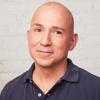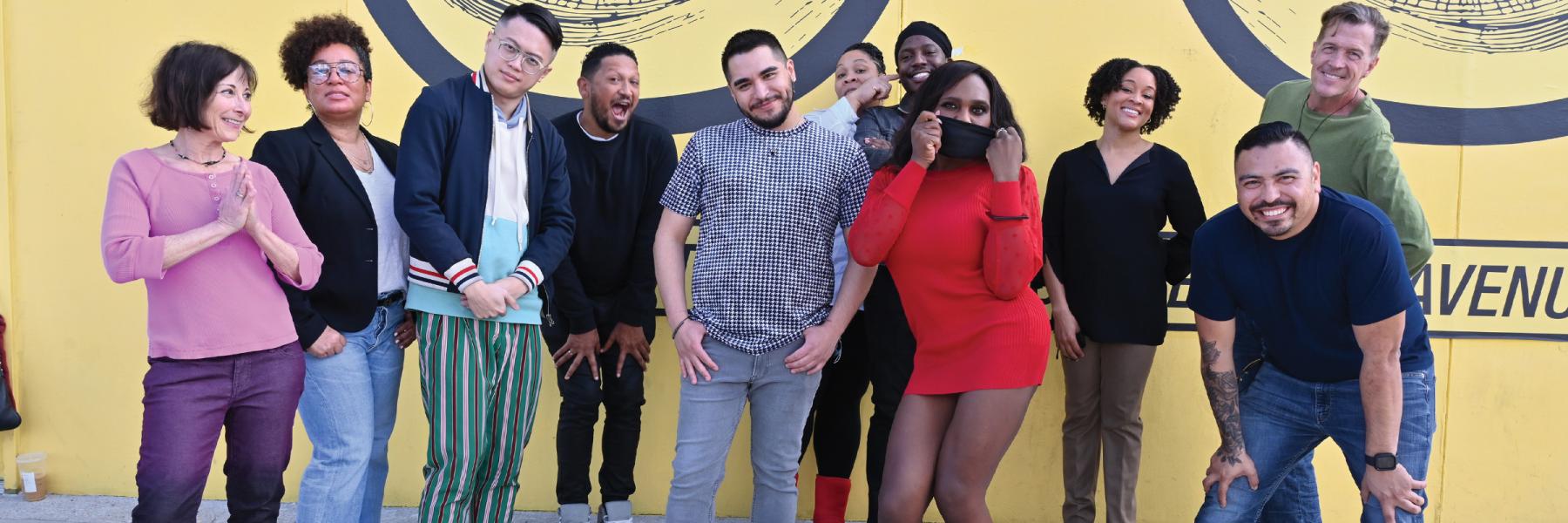
From the AIDS epidemic of the 1980s through today’s COVID pandemic, people living with HIV have endured isolation in one form or another while reaching for community to find support, information, and hope. We might be alone, but we’re also together.
That was the theme behind the Los Angeles photo shoot for the cover (and additional photos) of the 26th annual HIV Drug Guide, which brought together people living with HIV—both recently diagnosed and long-term survivors—and care providers in the HIV field, all passionate about their work, and some living with HIV as well. They each make a unique contribution, finding a place in the communities they serve.
“I have been an HIV advocate since first volunteering in the food pantry of an HIV service organization, nearly eight years ago,” says Danielle M. Campbell, MPH, an activist and faculty member of the Charles R. Drew University of Medicine and Science, a historically Black college, as well as at UCLA and the University of California at San Diego.
“Learning how HIV disproportionately impacted women of African descent globally, the decision to pursue this work was a logical conclusion. So many of my people were being affected, I couldn’t resist joining the ranks alongside others doing this work,” she adds.
At 34, Damone Thomas’ HIV journey has taken him from Kingston, Jamaica, where he tested HIV positive in January 2008, to L.A, where he is now a health care worker and a retention specialist.
“I learned of my status when I decided to get tested, despite the fear of being gay in Jamaica,” he says. “Living with HIV motivates me to work in the field, to be at the table to help others living with HIV, and try to help people who are HIV negative to remain HIV negative.
“My turning point in facing life with HIV came in September 2011,” he says. “I decided I wanted to live, because there is so much to gain. Today, I thrive above HIV.”
As an undergrad at California State University, Northridge, Alfredo “Freddy” Favela, MPH, was passionate about sexual health, often advocating on campus for safer-sex practices. Pursuing his master’s degree in public health with an emphasis in epidemiology at Los Angeles Pacific University, he began focusing on communities of color. Favela is now community outreach supervisor and community engagement lead at UCLA’s CARE Center.
In 2011, Mallery (“Mally”) Jenna Robinson was studying for a double bachelor’s degree in biology and history in Montgomery, Alabama, when she collapsed at the restaurant where she worked. Two weeks later, she learned she was living with HIV.
“I was completely overwhelmed as a then-21-year-old Black trans woman, but I was determined to not let this diagnosis deter me from living my best life,” she says. Today, she advocates for women of all trans identities and is a member of the Los Angeles County Commission on HIV.
“As a Black trans woman who has been living with HIV for over 10 years, I just want to say it’s okay to be nervous and overwhelmed,” she says, “but dig deep and find that determination and tenacity to survive and thrive so you, too, can motivate and inspire others.”
Being public about his status helped Oliver Wong, 30, overcome isolation and stigma. Diagnosed barely a year ago, he’s even made it part of schtick. “As a stand-up comedian, I also talk about being HIV positive,” he says. “It helps me to share my experience onstage. It’s very therapeutic, empowering, and freeing to talk about it. If you’re living with HIV and turn your experience into art and share it with the world, it’s gonna not only help you, but also help the world understand HIV and remove stigma.
“If you are newly diagnosed, it’s important to talk with someone who has been living with HIV for a longer time,” he says. “Hearing firsthand experiences from a long-term survivor can give you assurance that HIV is manageable.”
Carlos Moreno, 31, came out to his family, friends and coworkers by telling his story onstage during a concert by the Reveille Men’s Chorus in Tucson, Arizona, in May 2015.
“My entire life changed after that,” says Moreno, whose pronouns include he and they. “I no longer carried the heavy burden of secrecy. This opened up many doors for me, and just a couple months after coming out, I moved to Los Angeles to continue expanding my advocacy.”
For him, being visible means representing. “Folks needed to see people like myself living well, working, and thriving with HIV, as well as contributing to the field of service delivery for marginalized populations. This was something that I struggled to see in the early years of my diagnosis.
“Not everyone gets the chance or has the privilege to be out about their status, or to be a community advocate,” they acknowledge, “but know the rest of us do what we do because we love and honor you, and carry you with us.”
It was 1987, and Andrea de Lange, MS MFCC, didn’t fit “the type” who would have HIV. She had swollen lymph nodes, and her new doctor was trying to rule out possible causes. A cancer screening three years earlier had turned out negative.
“My doctor never thought I could be HIV positive when I got the biopsy, because I didn’t fit the stereotypes of who was HIV positive, and he also didn’t know about my past history with the boyfriend,” she says.
“The boyfriend,” an injection drug user, had turned her on to crystal meth, telling her that she needed to lose weight. The relationship lasted from 1981 to 1985, but she was already in another abusive relationship. “Starting a year before I was diagnosed, he treated me like a leper after I told him my status,” she says. “I let him live with me and treat me that way for another two years because I was so unempowered and thought I’d never be in a better relationship.”
Today, de Lange has been happily married for more than 19 years, “to an HIV-negative guy, who totally loves and accepts me, HIV and all,” she says.
After decades of practicing safer sex, Nicholas Snow says it was one moment that led to him acquiring HIV in August 2007. “I remind myself that I am human, and this was a human experience,” he says. “I don’t beat myself up for it, and I am loving and forgiving of myself. My greatest power is my ability to live and express my truth.
“My personal mission statement is to honor and express my creativity in a way that makes a difference,” says Snow, producer and host of PromoHomo.TV, an LGBTQ online platform.
“My status doesn’t weigh on me personally, except that stigma and ignorance are still pervasive within the gay male community, which makes it challenging to find love, but I haven’t given up,” he adds. “What about U=U [undetectable equals untransmittable, the message that a person with undetectable viral load is not able to transmit HIV to a sexual partner] don’t they understand?”
In medical school, Alicia Morehead-Gee, MD, MS, 34, was fascinated by the global impact of HIV/AIDS. At UCLA, her work focuses on HIV prevention and Black women. Today, she’s medical director of HIV prevention for AltaMed Health Services to expand PrEP (pre-exposure prophylaxis) awareness and access. “My team trains primary care providers, pharmacists, and staff on PrEP and PEP [post-exposure prophylaxis],” she says.
A young single mother of two, struggling to work and go to school, Dawn P. McClendon shifted gears from becoming a lawyer to promoting public health and to become part of something larger than herself. Now 48, she is assistant director of the Los Angeles County Commission on HIV.
“I am eternally changed by the relationships I have built with people living with and impacted by HIV as well as those who are a part of this workforce, and I am forever grateful,” she says.
José Magaña’s love of helping people helped him to overcome stigma. He learned of his HIV status about six years ago while getting tested to get onto PrEP.
“I told my sexual partner, and they did not want anything to do with me,” he says. “It took me a year of therapy to learn to love myself regardless of my status, whether people choose to accept me or not. Since then, I decided to educate and share my story with others to get rid of HIV stigma.”
At 39, public service has always been part of Magaña’s life. He’s been in the Army National Guard for 17 years, having spent over a year and half on deployment assisting hospital workers during the COVID-19 pandemic. He’s now a community organizer for The Wall Las Memorias Project, focusing on substance abuse and mental health, and facilitates a virtual group for people living with HIV that meets every Wednesday night via Zoom.
“I love to help people in the community that I am part of,” he says. “Everyone has a different story to tell and it’s important to share those stories so that others can learn and grow from them.”
About the photographer
Mark Harvey is a visual artist, designer, photographer, and educator living in Los Angeles. He also teaches a variety of topics in graphic design and photography at the Art Center, Pasadena City College, Glendale College, and at Los Angeles City College.


